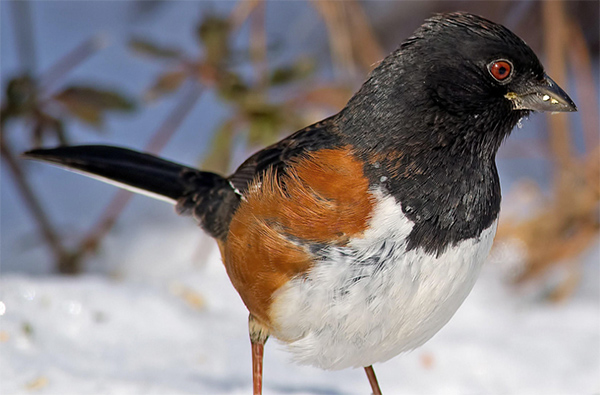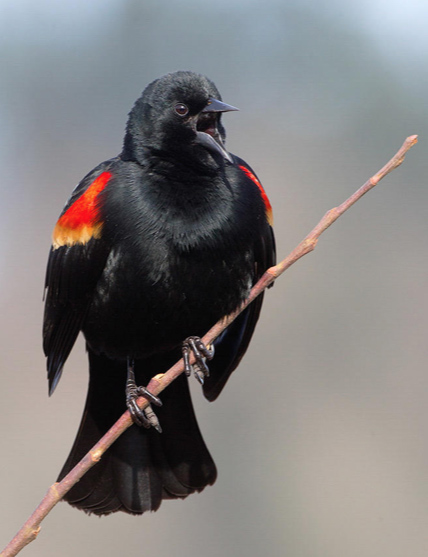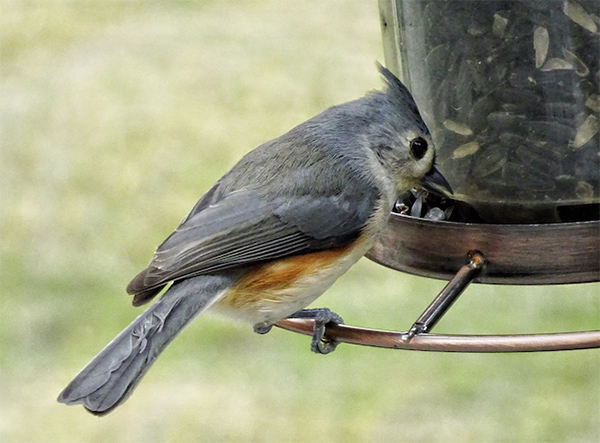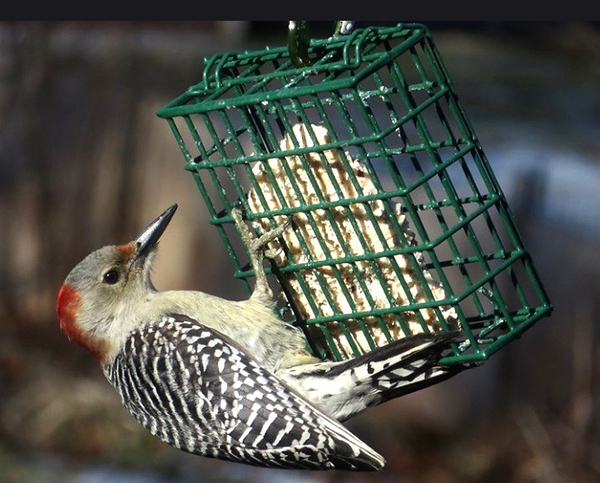Avid bird watchers, especially those who feed songbirds during the winter and into the green-up in late March, probably notice some new arrivals this time of year.
March is the beginning of a local and regional migration back to nesting grounds, but not all of these songbirds visit backyard feeders.
Early Arrivals

• The Eastern Towhee (Pipilo erythrophthalmus) is an infrequent visitor to bird feeders.
Consider yourself lucky to see this large sparrow, with distinctive plumage, feeding on the ground beneath one of your hanging feeders during the late winter or early spring. Towhees observed this time of year are likely migrants passing through, on the way northward, back to their breeding grounds. They live at the wood’s edge, in shrubby areas. For decades this species was known as the Rufous-sided Towhee, but in 1995 its name was changed.
• The Brown Thrasher (Toxostoma rufum) is a member of the family Mimidae, which includes Catbirds and Mockingbirds.
This rather large bird with long tail feathers is found year-round only in the warmer Jackson Purchase Region, but in the rest of the state, most birds move southward with the onset of cold weather, returning in March, to begin nesting.

The Brown Thrasher is not attracted to bird feeders, it forages on the ground, using its bill to flip dead leaves aside or dig in the soil as it rummages for insects. It also perches in shrubs and trees to eat berries.
It is most often observed driving Kentucky’s rural backroads during the spring and early summer, darting into brushy fencerows, or tangles of vines and honeysuckle at the wood’s edge.
• The Red-winged Blackbird (Agelaius phoeniceus) is considered a year-round resident, but many birds join up with migrants from northern states and move southward for the winter.
During the first warm days of late winter, males separate from their winter flocks, move northward and begin staking out nesting territories in early March. Females return later.
They forage on the ground, eating grass and weed seeds, and will readily come to bird feeders. During the summer, they feed on insects.
Feeding Songbirds
Feeding songbirds during the coldest weather of the year helps them pull through with improved body condition, heading into nesting, and provides excellent opportunities to view them up close at city parks, in suburban backyards, and in rural areas.
To attract a wide range of songbirds species put out mixed birdseed, black oil sunflower seed and suet cakes.
Mixed Bird Seed
Mixed birdseed is typically composed of a blend of millet, milo, cracked corn, peanut chunks and back oil sunflower seeds.

Fill hanging feeders and sprinkle some seed on the ground or in trays. Sturdy trays can be made with scraps of plywood and 2 by 4s. Mixed seed blends will also attract squirrels, and chipmunks, when they begin to come out of hibernation in late February.
Common seed-eating songbirds observed in central Kentucky during the winter months include the Dark-eyed Junco, American Goldfinch, Carolina Chickadee, and several species of sparrows, most notably the Song Sparrow and House Sparrow.
Also, expect to see a few insect eaters, who look for insects in the bark of trees. These birds shift their diets from insects to seeds and berries in the winter.
The insect-eaters include:
• The White-breasted Nuthatch (Sitta carolinensis) is a gravity-defying, busy little bird.
Hang your bird feeder, or suet cage, off a low-hanging tree limb, and sit back and enjoy the show.
This acrobatic tree climber is on the move non-stop, quickly going up, and down, head first, on a tree trunk or vertical limb, darting to the feeder for a black oil sunflower seed, or beak full of suet. Then it’s back to the tree, to cache the morsel in a crevice in the bark.
The White-breasted Nuthatch is omnivorous. Its diet is insects and spiders during summer, supplemented by seeds in the winter.
For its small size, about five inches head to tail and weighing less than an ounce, the White-breasted Nuthatch has a stocky build — a large head, short legs with strong toes and long claws, compressed wings, a square 12-feathered tail, and a long, sturdy, pointed bill.
Both sexes have a white face and breast, with dark eyes, a gray bill, and a black/dark gray cap. Their backs are pale blue-gray, with a black band. The lower belly is chestnut colored.
The White-breasted Nuthatch is a permanent, year-round resident of Kentucky that varies in abundance across the state.
• The Tufted Titmouse (Baeolophus bicolor) is identified by a crest of gray feathers on its head and its distinctive song.
In winter this friendly little bird readily comes to backyard bird feeders, carrying away black oil sunflower seeds one at a time to be eaten secluded from other birds, or cached for later.
The Tufted Titmouse is about six inches head to tail, with a gray back and tail feathers, whitish breast and dark eyes. Its sides are rust-colored. The head is distinctive, with a pointed, gray crest, square black patch on its forehead and short, stout bill.
They are omnivorous and feed mostly in trees. In winter at feeders, they prefer black oil sunflower seeds and suet mixtures with berries.
Black Oil Sunflower Seeds
Black oil sunflower seeds are the best bird food choice throughout the winter.
These small sunflower seeds will work in just about any size feeder. Use a tube feeder for small birds, and a hopper-style feeder, which loads from the top, for larger birds.

Black oil sunflower seeds are relished by this iconic songbird species, Kentucky’s state bird:
• The Northern Cardinal (Cardinalis cardinalis) brightens up cold winter days with visits to backyard feeders.
In Kentucky, the widely used common name for this native songbird is “Redbird.”
Coloration is distinctive. Both sexes sport red crests on their heads, and masks on their faces — black for the male, and gray for the female. The males’ feathers are a crimson red, while the females’ feathers are a reddish olive. Both sexes have cone-shaped red beaks.
The Northern Cardinal eats mostly seeds, but also insects and berries.
Its diet varies seasonally. The Northern Cardinal prefers to feed on the ground, finding food while hopping through trees and shrubbery.
A favorite backyard meal is black oil sunflower seeds, preferably piled on a tray, or in a large hanging feeder.
Beginning in March, the male Cardinal marks his territory with song and aggressively chases off intruding males.
Suet Cakes
Suet cakes are high energy, filled with fat and calories, with nuts, berries and seeds mixed in with the fat.
Woodpeckers are particularly fond of suet. Six species nest in Kentucky, but these two species are most likely to be seen eating suet this time of year:

• The Red-Bellied Woodpecker (Melanerpes carolinus) is found throughout Kentucky but is less abundant in the eastern third of the state.
This medium-sized woodpecker is found in a variety of habitats but seems to favor rural farmland with scattered woodlots, suburban yards, urban parks and riparian corridors.
A year-round resident, the Red-Bellied Woodpecker, readily comes to feeders in the winter. Nesting begins in mid-April.
Their plumage is black and white (barred) on their backs and wings, with a pale breast. Males have a red crown and nape.
Their preferred food is boring beetles, grasshoppers, ants and other insects, but they also consume nuts and wild fruits.
• The Downy Woodpecker (Picoides pubescens), the smallest woodpecker in the eastern U.S., is sparrow-sized, and the most numerous and widespread woodpecker in Kentucky.
They are found in all of the state’s forest types, yet seem to prefer farmland woodlots, large urban parks, and wooded suburban neighborhoods. Very fond of suet, this approachable little woodpecker is a common visitor to backyard bird feeders.
Plumage is black and white with numerous white spots. Males have a small red patch on the nape of the neck. Nesting territories are established by mid-April.
Late winter, early spring is a transitional period for songbirds, as local and long-distance migrants return to their nesting territories in central Kentucky. We are truly blessed to have such a wide variety of these winged wonders.






















Love your articles. Thank you. Keep up the good work!